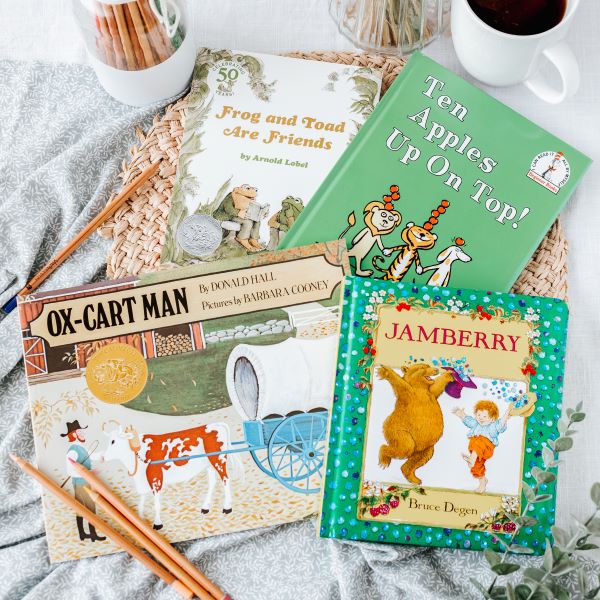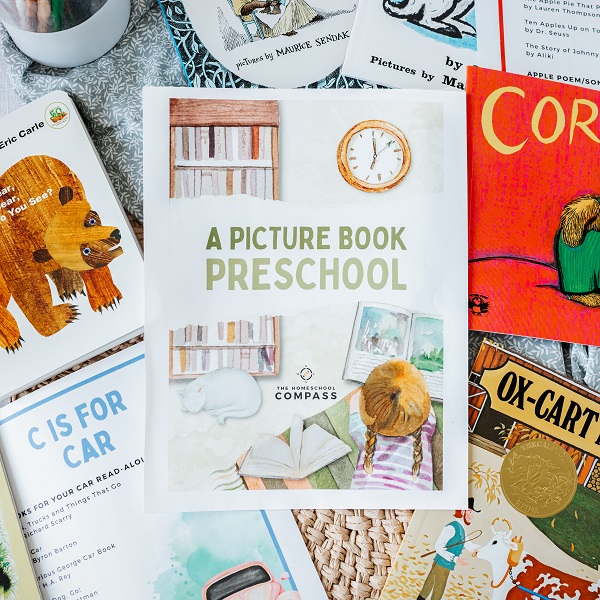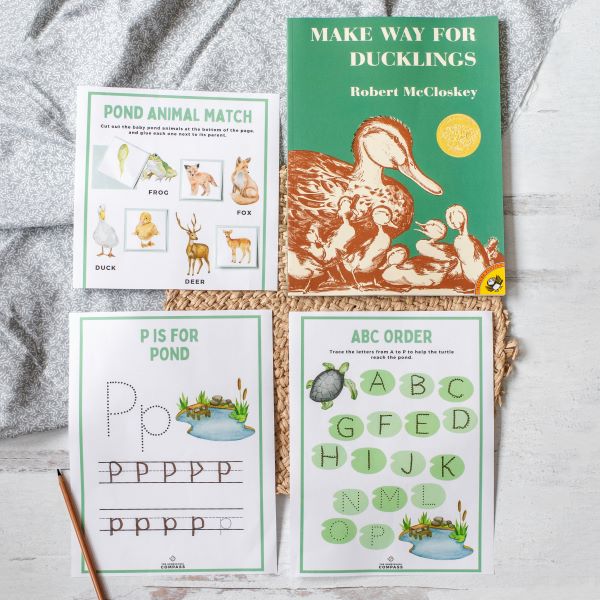If you’ve heard us say anything about homeschooling the early years, it’s probably that you don’t need an official curriculum for preschool. We wholeheartedly believe that the best way to spend these precious years is with a good stack of picture books. That’s why we’ve created A Picture Book Preschool to help you savor your child’s preschool years while enjoying beautiful songs, stories, and activities together.
What Is A Picture Book Preschool?
A Picture Book Preschool is an affordable, printable preschool program perfect for ages 3 to 5. It’s designed to help you to ease gently into the rhythms of homeschooling in a way that fits your budget.
A Picture Book Preschool is not a formal curriculum. There are no rigid schedules or timetables to follow. Instead, you’ll find over 250 pages of printable material organized into 26 units, one for each letter of the alphabet that you can implement as you see fit.
In each unit you will find:
- A recommended list of classic picture books (this is the heart of the program)
- A song, nursery rhyme, or poem
- Coloring pages
- Worksheets to practice handwriting, phonics, and math in a developmentally appropriate way
- Hands-on activities including crafts, science experiments, and recipes
We’ve intentionally kept this program flexible. That’s because we believe homeschooling works best when you as a parent seek the Lord’s wisdom in determining what will work best for your unique family. You do not have to use all the activities, worksheets, or coloring pages for each unit. You can do as much or as little as you want!
Loving Connection + Stories + Play = Preschool
We believe that God designed loving, connected families as the perfect place for learning to occur. Generations of homeschool families can attest that there is no better educational setting for your little one than a safe, loving home.
Your child will likely learn best through short, consistent times of focused learning with you. Try to establish a moment in your daily routine when you set aside time to enjoy these stories and activities together. Even if you don’t use the program every day, a gentle daily routine will give you a strong foundation to build on as your homeschool grows.
Here are some ways other homeschool families have implemented A Picture Book Preschool:
- Create a book basket using the recommended titles from A Picture Book Preschool as well as other books you already have on hand. Each day after breakfast spend some time cuddling on the couch and letting your child choose books from the basket for you to read together.
- Before you begin homeschooling your older children, have a special time with your preschooler where you sing the nursery rhyme or song together and read one of the picture books. Then set your preschooler up at the table next to you with one of the coloring pages or worksheets while you work with your older children.
- Read one of the 5 recommended titles with your child each day and choose one activity to do afterwards.
- Print out an assortment of worksheets and coloring pages and have them bound in your child’s own special school book. Let them pick one page to do each day.
The possibilities are endless. Let us know how you like to use A Picture Book Preschool! We’d love to hear from you.
What Other Families Are Saying About A Picture Book Preschool
“Beautiful and thorough! This is everything I wanted and more. All the options with every letter make this a perfect introduction to school for my pre-k age kids. I can choose how much to do and when to do it. I love the book lists to go with the letter theme and all the activities mean I don’t have to do any additional planning. Perfect for busy moms and eager to learn kids!”
“We bought this, and I’m really happy with it. It’s so affordable! My library has most of the books, and adding in a few crafts we will have a full preschool year at home.”
“I just bought this for my 3-year-old, and she loves it. We’re having so much fun with it. We travel full-time around the world so having lots of books on hand isn’t an option for us. I uploaded the PDF to her tablet. Now she can draw all over it, trace the letters, and do the activities without us needing to pack extra workbooks. Game changer!“
Where Can I Get A Picture Book Preschool?
A Picture Book Preschool is available for purchase as a digital download at Christianbook.com. Once you complete your purchase, you will be able to download the full PDF onto a device of your choosing and print as many copies as you like for use within your own family. There is also a small group license available for purchase if you would like to use A Picture Book Preschool with your co-op, learning pod, microschool, or farm school.
Where Can I See a Sample?
You can view the first 21 pages of the PDF including the entire first unit (A is for Apple) at Christianbook.com.
What Are the Themes for Each Unit?
Great question! There is a different theme for each letter of the alphabet. You can go in order or jump around based on the season and your child’s interests. Here is a list of the themes:
- A is for Apple
- B is for Bear
- C is for Car
- D is for Dog
- E is for Egg
- F is for Farm
- G is for Garden
- H is for Hat
- I is for Ice Cream
- J is for Jam
- K is for Kite
- L is for Leaf
- M is for Moon
- N is for Nest
- O is for Otter
- P is for Pond
- Q is for Quilt
- R is for Rabbit
- S is for Snow
- T is for Tree
- U is for Umbrella
- V is for Vegetable
- W is for Whale
- X is for X-Ray
- Y is for Yellow
- Z is for Zoo
Where Can I See the Recommended Picture Books?

You can check out the recommended titles for each theme here! As with everything in this program, the book recommendations are flexible. We’ve curated a list of timeless picture books that are well-written, beautifully illustrated, and filled with inspiring stories, but you can always substitute beloved books from your own home library.
What Else Should I Be Doing with My Preschool Child?
There are so many ways to cultivate a rich home atmosphere for your preschool child. What they need most of all is YOU! So put your phone down, look them in the eyes, invite them into your world, and really listen to them. In addition to just being together, here are a few things to consider as you move through your days with a preschooler:
- Read, read, read. There’s no such thing as too much reading in the early years. When my children were small, I resolved that I would read to them anytime they asked. No matter what I was doing, with a few exceptions like talking on the phone or helping a sick sibling, if they came to me with a book and asked me to read it to them, I would immediately stop what I was doing, sit down, and read. I’m not saying you have to be as extreme about this as I was, but now that my kids are older, looking back I can absolutely say I’m so glad I did this.
- Immerse your child in real, spoken language. Talk with them as you’re going about your day. Explain to them what you’re doing. This narrating that you do as you move through the day is amazing for your child’s verbal development. Try not to get too frustrated with the endless stream of questions coming at you from your preschooler (we all get frustrated sometimes). As much as you can, answer them clearly and frankly. Don’t talk down to them or use baby talk. Help them dig for the knowledge they seek.
- Good podcasts and audiobooks are another way to expose your child to language. Don’t limit them to books and stories that are supposedly “on their level.” They will be capable of taking in stories well beyond their official grade or reading level. Let them listen to audiobooks while they play with blocks, color, or play with stuffed animals. You might even want to have a special time each day when your child listens to an audiobook or podcast while playing quietly in their room.
- Speaking of play, leave room for play. Play is essential in the early years, so make sure you have plenty of down-time in your daily rhythm. That will probably mean setting some limits around how much screen time you allow in your home and being thoughtful about your toy selection. The kind of play that benefits kids most is open-ended, unstructured exploration where they are free to imagine and be creative. Head here to read about some of the kinds of toys we brought into our home in the preschool years to foster this kind of play.
- Spend time outside. Nature really is one of our children’s best teachers. Grand outings and day trips are nice, but a simple daily walk around the block or time spent puttering around the yard can do wonders as well.
- Resist the urge to hurry your child on to the next thing. If they want to spend all morning building the same stack of blocks and knocking it down over and over again, or staring at a worm on the sidewalk, or standing by the creek and drop leaves in one by one, or swirling bubbles in the sink, as much as you can, let them. If you can leave your phone in your pocket and be present with them, that’s even better. Of course, there will always be a baby to feed, or laundry to change, or a child that is minutes away from an exhausted meltdown and needs to be brought home and put to bed. There are many valid reasons for needing to interrupt a focused little one. But often we rush our kids away from what they’re doing because we are bored or busy. That robs our children of the opportunity to develop focus and attention, and it makes our lives more complicated as we train our children to depend on us for endless entertainment. We would do much better to adopt what Charlotte Mason calls “a wise and purposeful letting alone.”
- At this age children long to feel capable, so help them develop meaningful skills. Assign them a daily chore to complete (with your help at first). Invite them to cook or bake with you. Give them opportunities to work with their hands by beading, finger knitting, making greeting cards with stamps and ink, or painting. These are all great ways to grow your child’s confidence and help them feel that they are a valuable part of the family.
Shouldn’t I Be Doing More Academics?
As with so many things in homeschooling, it depends on the child. If you have a three-year-old who is pushing for more bookwork, there’s no reason to hold them back. Give them the instruction they’re craving. But there’s also no reason to force a four- or five-year-old to do endless workbook pages if they’re not interested. Many families delay formal academics until age six (or later). Your child is still learning even if you’re not officially “doing school” with them.
If your child is five or six, and they seem ready to bridge from A Picture Book Preschool to more formal academics, I recommend picking one of the following to add in. If you’ve already built in a routine of reading books from A Picture Book Preschool together at a certain time of day, you can easily add one of these on to that time:
- A Kindergarten math program like Kindergarten Math with Confidence, Saxon Math K, or Math-U-See Primer
- A more comprehensive handwriting book to teach printing like Handwriting without Tears Letters and Numbers for Me, A Reason for Handwriting K, or Zaner Bloser Handwriting Grade K.
- A phonics-based program to begin teaching your child how to read like The Ordinary Parent’s Guide to Teaching Reading, Teach Your Child to Read in 100 Easy Lessons, or All About Reading.
I recommend picking one of these three areas to focus on first. Give yourself a few weeks to assimilate that into your daily routine, then add in the second area, and a few weeks or months later bring in the third. Continue to read, read, read. Twenty to thirty minutes working on a math lesson, five to ten minutes working on handwriting, ten to fifteen minutes of formal phonics instruction and all the reading aloud you can manage with plenty of outside time and free play mixed in is an excellent kindergarten program.
That’s right. You can send your kid to public school kindergarten where they’ll spend 3-6 hours a day in the classroom, or you can do 45-60 minutes of instruction time at home. It really can be that simple!
Where Can I Get More Help for Doing Preschool At Home?
Check out the Homeschooling the Early Years section on the Homeschool Compass blog for helpful articles like these:
- Homeschooling Your Littles: The Value of Learning Through Play
- Teaching Preschool Math at Home
- Nurture Your Child’s Language Development
- Is My Child Ready to Read?
- Teaching Science to Little Ones at Home
This post contains affiliate links. Thank you for supporting the Homeschool Compass by shopping through our page!

